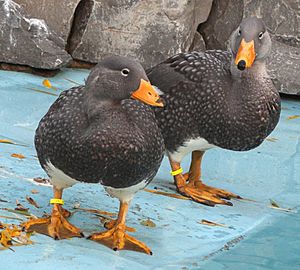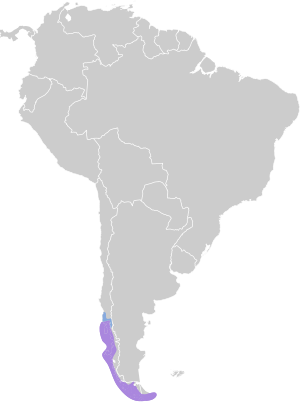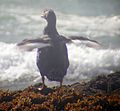Fuegian steamer duck facts for kids
Quick facts for kids Fuegian steamer duck |
|
|---|---|
 |
|
| Conservation status | |
| Scientific classification | |
| Genus: |
Tachyeres
|
| Species: |
pteneres
|
 |
|
The Fuegian steamer duck (also known as the Magellanic flightless steamer duck) is a unique type of duck that cannot fly. It lives along the rocky coasts and islands of southern Chile, including Chiloé, all the way to Tierra del Fuego in South America. When it's time to breed, these ducks sometimes move to calmer bays and lakes further inland. They belong to a group of ducks called steamer ducks.
What Makes Them Special?
This is the biggest kind of steamer duck. It's a very strong and heavy bird, weighing between 3.5 and 7 kilograms (about 7.7 to 15.4 pounds). It can be 65 to 84 centimeters (about 25 to 33 inches) long. Male ducks are usually bigger than females. Males weigh around 5.34 kg (11.8 lb) on average, while females weigh about 4.2 kg (9.3 lb).
Even though they have wings, their wings are too small for them to fly. Instead, they use their wings like paddles to help them skim very fast across the water's surface. These ducks are heavier than any other wild bird called a "duck." They are even as heavy as some of the largest wild geese, though they are not closely related to most true ducks.
Male Fuegian steamer ducks have a blue-gray head and neck, with a lighter color on their forehead. They have a thin white ring around their eyes that continues as a stripe, and their throat is reddish-brown. Their belly and underside are white, and their tail is gray. Females have a darker gray-brown head and a dark reddish throat. Their body and wings look similar to the males, but they might have some brown or wine-colored feathers. Young ducks look like the females but have slightly duller colors.
Life Cycle and Habits
These ducks build their nests near water, hidden in thick bushes, or sometimes they use old penguin burrows. They lay their eggs between September and December. A female usually lays between 4 and 11 eggs, with about 9 eggs being common. The eggs are ivory-colored and weigh around 167 grams (about 5.9 ounces).
The eggs hatch after 28 to 40 days. The young ducks learn to fly (or rather, swim very well!) and become independent after 120 to 130 days. After this, their parents encourage them to leave the family area. These young ducks then join groups with other young steamer ducks. They are ready to have their own babies when they are 2 to 3 years old.
Adult male Fuegian steamer ducks are known to be very protective and can be quite aggressive during the mating season, even towards other water birds. However, in winter, they might join groups of different bird species without any problems.
Several animals might try to eat the eggs or young ducks. These include foxes, caracaras, gulls, skuas, and giant petrels. In 2009, a marine otter was seen catching a chick of this duck species. Healthy adult Fuegian steamer ducks usually don't have natural predators.
These ducks mostly eat saltwater molluscs (like clams and snails), crustaceans (like crabs and shrimp), and small fish. During the breeding season, they also eat and feed their young small snails, insect larvae, and tiny creatures called amphipods and isopods.
Adult male Fuegian steamer ducks are famous for how strong and aggressive they can be. There are stories of them using their powerful, spurred wings to defend themselves and their territory.
See also
 In Spanish: Pato vapor austral para niños
In Spanish: Pato vapor austral para niños





